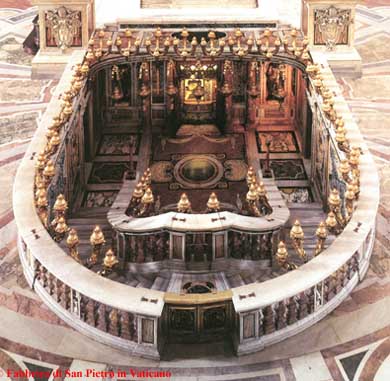
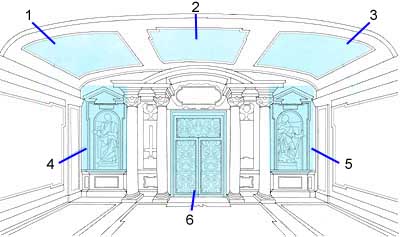 |
Carlo Maderno 1615-1617
The word
'Confessio' refers to the Confession of faith by St.
Peter which lead to his martyrdom. Here the
Confessio area is the space created directly in
front of the tomb of St Peter. This semicircular
space located at the level of the grottoes is accessed
by a double staircase.
The niche at the end of
the Confessio, directly under the altar and closest to
the tomb, is called the Niche of the Pallium. In this
niche, is placed a bronze coffer with fabrics (stoles
called "pallium") woven from the wool of lambs blessed
on the feast of St. Agnes (Jan 21) and bestowed upon
patriarchs and metropolitans as a reminder of the
Church's unity
|
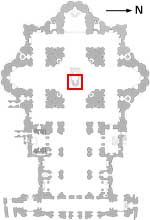 |
|
The bronze coffer,
donated by Benedict XIV, was
on permanent display, but this lead to the confusion of people thinking it
held the bones of St Peter. It is now only placed
here when it holds the palliums on the night before June 29, the Feast of Sts.
Peter and Paul. On this Feastday the pope
bestows the
palliums. |
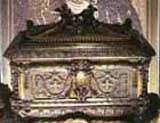 |
Carlo
Maderno started work on the Confessio in 1615, the same
year the dividing wall erected by Paul III, between the old and
new basilica, was demolished. It is
a version of the stairs that Maderno built leading down to the
crypt of Santa Susanna in the 1590s. The existence of a Confessio is attested since
the ancient foundation of the basilica, but
the present structure and rich decoration dates
to the time of Clement VIII, and for the most
part to Paul V. It was discussed in 1606,
announced in 1611, and built from 1615-1617. The pope decided to
make this area visible, and provide a balustrade with steps to
go down and celebrate mass close to the body of
St Peter. Previously, the area was
accessed only by a small passageway in the grottoes. The new arrangement gave St Peter's Tomb its former central
role.
The balustrade is in white marble with 74 brocatel
balusters alternated by 24 small pillars of eastern alabaster.
The steps were made from parts of the architrave of the old
basilica, and doubtless still retain Constantinian molding on
the undersides. Martino Ferrabosco presented an earlier design,
but the plan realized is by Maderno. An entrance
from the basilica floor has a
gate decorated with heraldic lilies from
the coat of arms of Pius VI. The polychrome
marble balustrade is an important place for prayer and the
veneration of St Peter.
|
Three frescoes by Giovan Battista Ricci
1.
St Anacletus has a small chapel
built over the tomb of St Peter
2.
St Sylvester consecrates the altar
in the presence of Constantine
3.
Paul V kneels in prayer with his cardinals before the recently
decorated Confessio
|
The Confessio is closely associated with the
pallium, which is a circular band of white wool with six black
silk crosses that the pope places on the shoulders of each
archbishop appointed during the past year. It symbolizes the
twin responsibilities of shepherding the flock entrusted to him
and fostering communion with the vicar of Christ. This event
takes place each year on June 29, the Feast of Sts. Peter and
Paul, to remind each Archbishop that he is to be a shepherd in
union with Peter and an evangelizer in imitation of Paul. Before an
archbishop is granted the pallium, it is left overnight in a
bronze coffer in front of the
niche. This provides a direct connection to St
Peter, a symbol of the Apostolic Succession, and
continuity from the Apostles. The pallium serves as
a badge of the Archbishops authority. |
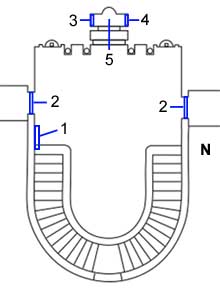
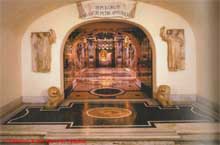
Opening from the Grottoes
into the Confessio
|
1. Coat of Arms Paul V
2.
Gates leading to the Grottoes
3. St Peter mosaic
4.
St Paul mosaic
5.
Niche of the Pallium
The mosaic of Christ is from the 9th century.
The two of Sts
Peter and Paul were also ancient, but
remade in 1625 and refurbished in 1863.
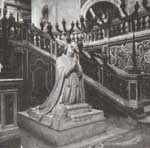
Pius VI statue
|
The oil lamps in gilded bronze cornucopias, burn
night and day around the shrine; these are by Mattia De Rossi.
The reported number of oil lamps around the Confessio has been a
matter of some confusion. It is recorded that 89 lamps
adorned the area since the 17th century. This was changed in
1963 to allow for a portable extension of the Papal Altar
platform over part of the Confessio, requiring the removal of
some of the lamps. This
arrangement allows for 55 candles: : 46 oil lamps of the
cornucopia type and 7 large lamps hanging before the Niche of
the Pallium. In addition, there are two small candles directly
in the Niche, behind which rests the bones of the Apostle.
With the platform
removed, there are then
99 candles.
Cornucopia oil
lamps: 7 groups of 3, and a single group of 2 on each
side of the balustrade;
8 groups of 4 in front of
the Papal Altar;
12 along the inner stairs,
Hanging lamps:
7 in front
of the Niche of the Pallium.
Small candles: 2 in the
Niche of the Pallium.
|
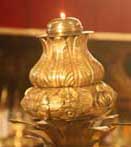
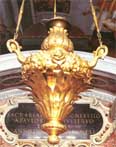
|
The Confessio was not originally open to view
from the grottoes, and held the statue of Pius VI, kneeling in prayer, one of the last works by Canova.
On November 2, 1979, Pope John Paul II inaugurated a new opening
that allows visitors to the grottoes to view the tomb of St
Peter. A dividing wall was opened with an arch containing glass
panels, and Canova's statue was moved back into the grottoes. An inscription above the arch contains the words:
SEPVLCRVM SANCTI PETRI - APOSTOLI. Two high reliefs of
angels, probably from the monument of Boniface VIII (1295-1303)
in the old basilica, were placed on the sides. Two medieval
marble lions that once decorated the sarcophagus of Urban VI
(d.1389) were placed at the base of the opening.
On the
inside walls of the arch are two Latin inscriptions. The one to
the left is a quotation from Sermon IV of St Leo the Great from
444, delivered on the anniversary of his consecration, stating
that all the churches, shepherds and faithful converge on Peter,
who is the center of the Ecclesiastical unity. The
inscription to the right commemorates this new layout completed
by Pope John Paul II.
|
When
the Confessio was being built, excavations had to be done on the
level of the grottoes for the new foundations of the stairways.
A number of ancient Christian monuments were discovered, right
in front of the tomb of Peter. These were drawn with
topographic precision by Benedetto Drei, on his
map of the grottoes. He even
indicates where the earth from the Confessio was taken: to the
southern end of the old grottoes, more or less where the tomb of
Pius XII is today.
"Many tombs of saints were found
there, as I myself saw (in the presence of Cardinal Evangelista
Pallotta, the arch-priest of this basilica, of the Canons and
others), including a Pope of imposing stature wearing a chasuble
and a Pallium. He was not touched, however, as by high
orders he was immediately covered. Many other corpses were found
bandaged with stripes an inch wide. Moreover, in another
three-palm high coffin, the corpse of a child was found, but it
was not touched either. In another one, the inscription Linus
was found, yet another one gave out an odor that everyone
present considered miraculous, as someone who was present
referred to me. One coffin with a body in it had to be taken out
as it was in the way, and it was transferred to the wall
(of the peribolos)." |
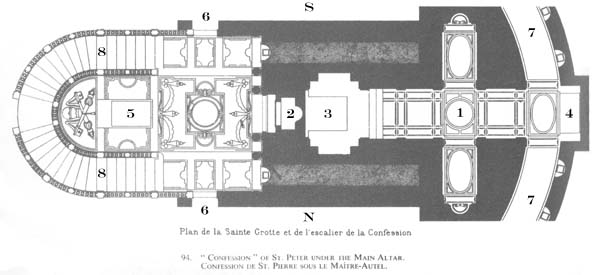 |
Confessio and Clementine Chapel
Letarouilly, 1882
1. Clementine Chapel
2. Niche of the Pallium
3. Altar of Clementine Chapel
4.
Tomb of Pius XII
(previously Sarcophagus
of Junius Bassus)
5. Previous position of Pius VI statue
6. Entrances from the Grottoes
7. Circular corridor of the
Grottoes
8. Stairs of the Confessio |
Sources:
Vittorio Lanzani, The Vatican Grottoes, 2012
Antonio Pinelli,
ed, La Basilica di San Pietro in Vaticano, 2000
Fr Jeffrey
Kirby, 101 Surprising Facts about St Peter's, 2015
Howard
Hibbard, Carlo Maderno, 1971
Toynbee and Perkins, The Shrine
of St Peter and the Vatican Excavations, 1957 |
Related Links:
The Grottoes
Papal Altar |
|

